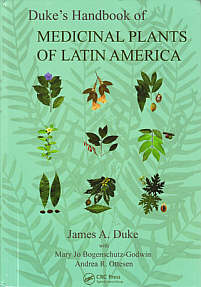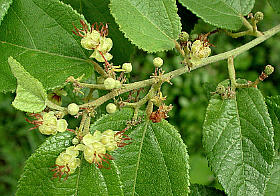Mutamba, also known as "Bastard Cedar," "bay cedar," and "West Indian elm," is
medium-sized tree, growing up to 30 meters high, common to pastures and disturbed forests.
Like
, it is prized both for its value as
a hardwood as well as its medicinal uses. Its range of distribution is parts of Mexico,
the Carribean, and Central/South America.
Uses & Protocols

Ethnobotanical, medical uses for Mutamba
tend to first make use of its antimicrobial profile: it is first used to
treat hepatosis, nephrosis, prostatosis, uterosis, dermatosis, gastrosis,
pulmonosis, elephantiasis, diarrhea, dysentery, and even gonorrhea. Other medicinal uses
include: childbirth, colds, flu, for use as a diuretic and depurative, etc.

A more recent and interesting medicinal application
is the treatment of male pattern baldness. Japanese researchers reported in a series of
studies (2000-2002) that
procyanidin B-2, of which Mutamba is rich, promotes hair
cell growth and increases the total number of hairs on a "designed hair scalp." (Taylor, p. 368)
Warnings & Contraindications

Contraindicated for those who are pregnant,
have a heart condition, particularly where hypotensive and/or where antihypertensive
drugs are taken.
Shelf-Life

Five years or more.

Medicinal Activities
 Further information for practitioners:
Further information for practitioners:
World-famous botanist Dr. James Duke attributes the following activities
to this plant
(p. 338-241; see hardcopy cover at right),
drawn from the extant literature. (See his graduation for "level of
efficacy" on our
amazon traditionals page;
followed by Duke's bibliographic abbreviations (in capital letters),
which we
identify
on a separate page.)

Duke provides a "
food
farmacy potential" score for this plant of "FNFF=!!."
- Analeptic (1; TRA)
- Anaphrodisiac (f; VOD)
- Angiotensin Inhibitor (1; RAI)
- Antidote (comocladia) (f; AHL; JFM)
- Antiherpetic (1; TRA)
- Antiinflammatory (f; RAI)
- Antimelanomic (1; RAI)
- Antioxidant (1; RAI)
- Antiprostaglandin (1; TRA)
- Antiradicular (1; RAI)
- Antiseptic (1; TRA)
- Antitumor (f1; RAI)
- Antitussive (f; RAI; VOD)
- Antiulcer (f; RAI)
- Antiviral (1; RAI; TRA)
- Astringent (f1; AAB; AHL; JFM)
- Bactericide (1; AAB; RAI; TRA)
- Bronchodilator (1; TRA)
- Cardioprotective (f; RAI)
- CNS-Stimulant (1; TRA)
- Cytotoxic (1; MPG; TRA)
- Depurative (f; JFM; RAI; RAR; VOD)
- Diaphoretic (f; AHL; JFM; RAI)
- Digestive (f; RAI)
- Diuretic (1; JFM; TRA)
- Emollient (f; DAV; RAR)
- Febrifuge (f; RAI)
- Fungicide (1; RAI)
- Hemostat (f1; DAV; RAI)
- Hepatoprotective (f; RAI)
- Hypoglycemic (1; RAI)
- Hypotensive (1; RAI)
- Myorelaxant (1; RAI)
- Nephroprotective (1; RAI)
- Orexigenic (f; JFM)
- Parasiticide (f; MPB)
- Pectoral (f; DAV; WOI)
- Respirostimulant (1; TRA)
- Stomachic (f; JFM; VOD)
- Sudorific (f; DAV; IED; JFM)
- Tonic (f; VOD)
- Uterotonic (1; AAB; MPG; RAI)
- Vulnerary (f1; RAI; VOD)
Indications
 Further information for practitioners:
Further information for practitioners:
Duke provides the following indications for this plant:
- Alopecia (f1; DLZ; JFM; RAI)
- Anorexia (f; JFM)
- Asthma (f; JFM; RAI)
- Bacillus (1; MPG; RAI)
- Bacteria (1; AAB; MPG; RAI; TRA)
- Bleeding (f1; DAV; DLZ; IED; RAI)
- Blennorrhagia (f; DLZ)
- Bronchosis (f1; JFM; RAI; RAR; WOI)
- Burns (f; VOD)
- Cancer (f1; AAB; RAI)
- Childbirth (f1; AAB; MPG; RAI)
- Cholera (1; RAI)
- Colds (f; JFM; VOD)
- Coughs (f; JFM; RAI; VOD)
- Dermatosis (f; AAB; JFM; MPB; RAI; VOD)
- Diabetes (f1; RAI)
- Diarrhea (f1; AAB; RAI; VOD)
- Dislocation (f; JFM; VOD)
- Dysentery (f; AAB; JFM; VOD)
- Dysmenorrhea (f; DLZ)
- Dyspepsia (f; VOD)
- Elephantiasis (f; IED; JFM; MPB; RAI; VOD)
- Enterosis (f; VOD)
- Escherichia (1; AAB; RAI)
- Fever (f; RAI; RAR)
- Fibroma (f; RAI)
- Flu (f; TRA; VOD)
- Fracture (f; VOD)
- Fungus (1; RAI)
- Gastrosis (f; RAI; WOI)
- Gonorrhea (f1; JFM; RAI)
- Headache (f; VOD)
- Hematuria (f; DLZ)
- Hemorrhoids (f; JFM; VOD)
- Hepatosis (f; IED; JFM)
- Herpes (1; RAI; TRA)
- High Blood Pressure (f1; RAI; VOD)
- Infection (f1; AAB; MPG; RAI; TRA)
- Infertility (f; RAI)
- Inflammation (f; RAI)
- Leprosy (f; DAV; RAI)
- Malaria (f; JFM; RAI)
- Melanoma (1; RAI)
- Mycosis (1; RAI)
- Neisseria (1; RAI)
- Nephrosis (f; IED; JFM; RAI)
- Obesity (f; WOI)
- Pain (f; RAI)
- Parasites (f; JFM; MPB)
- Pneumonia (f1; JFM; RAI)
- Proctosis (f; JFM)
- Prostatosis (f; AAB)
- Pulmonosis (f; AHL; DAV; IED)
- Rashes (f; AAB; VOD)
- Respirosis (f1; RAI; RAR)
- Shigella (1; MPG; TRA)
- Sores (f; AAB; JFM; VOD)
- Sore Throat (f; JFM)
- Staphylococcus (1; MPG; TRA)
- Streptococcus (1; RAI)
- Sunstroke (f; JFM)
- Syphillis (f1; JFM; RAI; RAR)
- Ulcers (f; RAI)
- Uterosis (f; RAI)
- VD (f1; JFM; RAI)
- Viruses (1; RAI; TRA)
- Wounds (f1; RAI; VOD)





